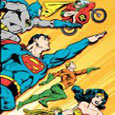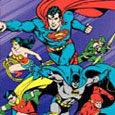Hanna-Barbera (1984), Warner Home Video (August 7, 2007), 2 discs, 179 mins plus supplements, 1.33:1 original full frame ratio, Dolby Digital Mono, Not Rated, Retail: $26.98
Storyboard:
The Super Friends invite a young new nuclear hero to join them, and they meet the intergalactic thug named Darkseid.
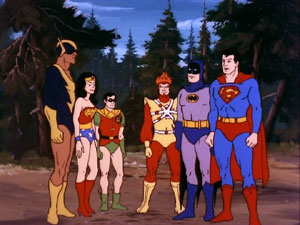
The Sweatbox Review:
Super Friends had been a ratings hit almost from its beginnings in 1973. A modest success initially, it only seemed to gather steam as it was rerun in subsequent seasons, and then later evolved into The All-New Super Friends Hour and Challenge Of The Superfriends. Challenge had finally brought on the bad guys, spotlighting DC Comics’ supervillains as well as its heroes, and 1984 would see yet another evolution of the show, a new version that featured DC’s most cosmic villain. This version of the show, like many cartoons of the 1980s, was heavily influenced by a toy company. The introduction of Kenner Toys’ “Super Powers” action figure line was a great opportunity to freshen up the show with some new blood, including using some new designs on certain characters to bring them more up-to-date with the comics, as well as bringing new characters in. It also gave the show its bulkiest title yet: Super Friends: The Legendary Super Powers Show, and had one of its shortest seasons, with just eight episodes produced.
Although Challenge Of The Superfriends had certainly brought in a vast range of new villains for the heroes to fight in the form of The Legion Of Doom, the new toy line and the TV show decided to give the team a single, major threat, in the form of Darkseid. Darkseid had been around in comics since the 1970s, as a main figure in Jack Kirby’s “Fourth World” series of comic books that included such titles as The New Gods and The Forever People. Darkseid was the cruel leader of the planet Apokolips, a harsh world on which Darkseid thrived on misery and despair. Until the advent of The Legendary Super Powers Show, Darkseid had largely been confined to appearing in the Fourth World books and their various follow-up series, except for a memorable Justice League-Justice Society team-up in 1980 that hinted at his larger potential. The latest version of Super Friends would finally see him take his rightful place as the uber-villain in the DC Universe. In retrospect, it is hard to believe that it took so long to happen, and that a toy line was largely responsible for his rise to power, but since the Legendary TV show and its accompanying Super Powers comic book miniseries, Darkseid has been a force to be reckoned with for all of Earth’s heroes. Darkseid (Frank Welker, using a gravel-y voice) was joined on the show by his advisor DeSaad (quirkily played by Rene Auberjonois), and his adopted son Kalibak.

Darkseid was not the only villain, present, however. The re-tooling of the show also saw two of Superman’s greatest enemies get a television facelift that was reflected in (or reflective of) the comics of the time. It was here that Luthor got his green and purple power suit, and Brainiac went from being a green humanoid robot to a skull-faced mechanical being. Other villains making an appearance included Mirror Master, Mr. Mxyzptlk (with two appearances), and Dollmaker (who was intended to be Toyman in the original script). Considering the small number of episodes this season, there was not much opportunity to showcase other villains, even given that there were two stories per half-hour episode (with two episodes featuring full-length stories). Of course, the show was meant to highlight the characters that appeared in the toy line, to the detriment of adding others.
As for the heroes, Aquaman finally got the boot this year, in favor of keeping Superman, Batman & Robin, and Wonder Woman in the spotlight. The Wonder twins, Zan and Jayna, still appear a few times, as do the “ethnic heroes”— El Dorado, Samurai, Black Vulcan, and Apache Chief. Despite what was suggested by the series’ opening and logo, there were no guest appearances by other Justice League members like Green Lantern or The Flash, but there was one major addition. Firestorm, introduced in the comics in the 1970s, was by 1984 a member of the Justice League, and the toy people saw something in him that was appealing. Firestorm had a unique costume, an interesting two-person alter ego, and he was younger than the elder Super Friends. Well, the part of him that controlled Firestorm was younger. Firestorm was a nuclear hero formed by the fusion of student Ronnie Raymond (the body) and Professor Martin Stein (the brains). His origin is explained surprisingly well in the first episode, Bride Of Darkseid, Part 1. Bringing Firestorm to the team created a brand new dynamic, particularly since he was actually given something of a personality, which the other members seriously lacked. Wonder Woman received a subtle redesign this season that saw her chest emblem changed into the double-W symbol in use by then in the comics, but she remained as dull as Superman and Batman.
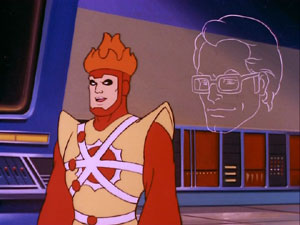
One thing that excited the crew on the show, and a number of fans as well, was that Adam West— former live action and cartoon Batman— had agreed to do Batman for this (and the next) season of Super Friends. The previous Batman, Olan Soule, remained with the show but switched to playing Dr. Stein.
With all the new elements brought to the show, one thing remained constant. Though comic fans might enjoy seeing their heroes engaged with bad guys onscreen, the quality of the show remained mired in mediocrity at best. This was far from the worst that Super Friends ever was, as it did not quite degenerate into the banal silliness that marked too many previous episodes. However, this was still a kids’ cartoon produced to sell toys, and consequently today there is not a lot in the show to appeal to adults who are not on a nostalgia trip. My own interest in seeing these characters kept me going through the set, but even my patience was tested. The stories are simplistic, although at least they do contain more jeopardy and conflict than what was allowed in the early seasons. Also, Darkseid’s wishing to make Wonder Woman his bride brings in the element of sex ever so slightly, and provides a common thread through a number of the episodes.

The quality of the artwork is perhaps a little better than it was in earlier seasons, where the artists often butchered poor Alex Toth’s designs. In Legendary, the drawing seems more consistent, but though the animation mistakes are kept to a minimum, it does remain limited. One of the great disappointments in this season is seeing Firestorm’s head-fire remain entirely static, rendering one of his coolest visual elements pretty useless in terms of visual interest. What is more bizarre is that, at least at times, the fire is given sound effects but no animation!
Seeing Darkseid interact with Luthor and Brainiac in different stories is actually kind of fun, and provide the highlights of this season, as you know the two flesh and blood scoundrels and the cold robot have no affection for one another. Other than that, there are the typically silly plots concerning Superman being trapped in a mirror dimension, Super Friends being shrunk, wacky magical hijinks with Mr. Mxyzptlk, a trip to a “mysterious island” of dinosaurs, and a town of people being taken over by an outside intelligence. Still, the kid in me manages to find this type of thing fun on some base level. Yes, it is all pretty inconsequential stuff, but for many of us this show defined our childhood, and as always that counts for something.
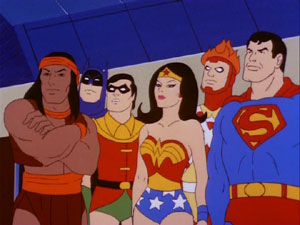
Is This Thing Loaded?
This is the best that Warner has done so far when it comes to special features on a Super Friends set. While previous sets offered the worst in puff pieces, this one brings a couple of substantial featurettes that are actually about the making of the show.

Evolution: New Heroes, Viler Villains and Ethnic Additions: How Super Friends Prefigured The Era Of Cultural Diversity In Animation (17:42) has comic book and cartoon creators alike discussing this version of Super Friends and what made it unique. From Firestorm creator Gerry Conway to DC President Paul Levitz, everyone has something interesting to contribute. Numerous model sheets are shown during the interviews, nearly making up for the lack of a stills gallery on the set. The only odd thing about the interviews is that everyone seems to have forgotten that Challenge Of The Superfriends was the first version to bring supervillains to the show in a big way. Many of the same people appear in The Super Powers Collection: The Effect Of The Toy Industry On The Super Friends (7:37), which goes more in-depth about the action figure line and how it shaped the show. Many of the action figures are shown, including how they demonstrated their own super powers. Combined, these two featurettes represent nearly a half-hour quality look behind the production of the show.
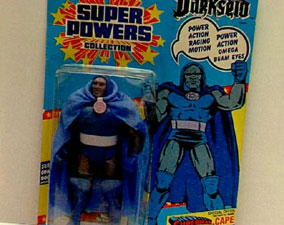
There are also five Audio Commentaries by DC Comics writer and historian Mark Waid and each story’s respective writer. The first one, on The Wrath Of Brainiac, gets one of the better ones, discussing the Kenner influence on the show and the origins of some of the character redesigns; Waid also provides some comic book history. The next couple of commentaries get a little fluffy, but then Disc Two’s commentaries pick up the slack again. On The Case Of The Dreadful Dolls, we get a discussion of the “minority heroes”, and on The Royal Ruse there are comments made about the writing limitations due to the short stories and the dictates of Standards & Practices.
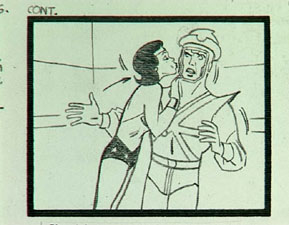
Disc Two also opens with a trailer for Superman: Doomsday, and from the menu you can view one of the Previews making frequent appearances on Warner sets these days (Smurfs, Space Ghost/Birdman/Droopy, Popeye, Teen Titans, The Batman), plus Challenge Of The Superfriends.
Case Study:
Typical of the previous two Super Friends sets, this one has some attractive artwork that is nevertheless not indicative of the show itself. The slipcase is fine, but the digipack inside (containing two overlapping single-sided discs) has Justice League characters that do not appear on the show itself. The Flash’s emblem is also drawn and colored wrong on the back of the digipack, but then, he’s not even on the show, so…. Aside from these nitpicks, though, it’s a nice package. My other suggestion would have been to have Firestorm or Darkseid pictured on the front or back cover, to more easily differentiate which version of the show this is, for those who cannot remember which title went with which incarnation.
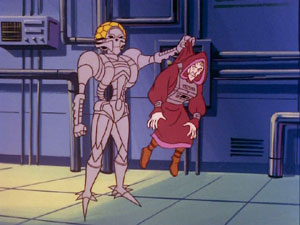
Ink And Paint:
The compression work is fairly good, with only some occasional shimmer reminding you that you are watching a digital presentation of the show. The transfers are generally solid, with the main artifacts being those inherent to the process of producing cheap animation that was largely shipped overseas— lots of smudges and dust. Overall, it looks better than what I saw on cable back in the day, so I guess I am pleased.

Scratch Tracks:
The English mono soundtrack is as good as it should be, and of similar quality to Warner’s other cartoon DVD efforts. Sounds are distinct, but of narrow range. At this point, we were still a long ways from the more bombastic soundtracks of Justice League. English subtitles are also available.
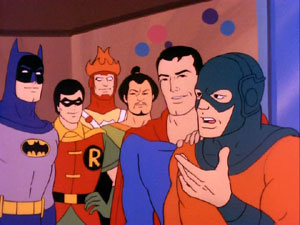
Final Cut:
This show never changed the world, but a generation of us grew up loving it. This season has a little more edge and a little less silliness than previous incarnations, but at its heart it is still a kids’ Saturday morning cartoon show used to help sell a toy line. Anyone coming to the show for the first time will undoubtedly compare it unfavourably to contemporary DC cartoons, but Super Friends remains a great entry point for younger viewers. With a string of good audio commentaries and two quality featurettes, this is in some ways the best Super Friends package out there. It is not the best deal, however, as there are only eight episodes on the set, and you won’t see the same diversity of characters as on Challenge Of The Superfriends. If you are trying to make a choice, you may wish to consider those points, but if you’re like me you’ll just take the easy way and collect it all.
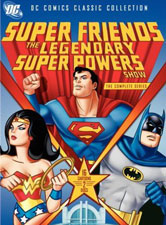 | ||
 |







